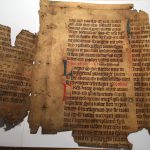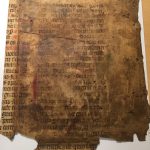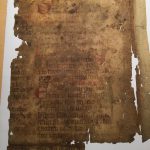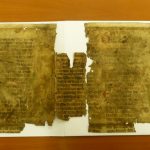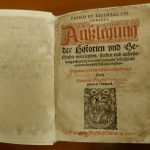Based on Janka Szendrei’s handwritten notes from 1981 the book came from the heritage of Ágoston Pável, a guard of the Library of the Szombathely Museum (the forbear of the Berzsenyi Dániel Library). In Szendrei’s time the fragment was still attached to the host volume.
The host volume contains the preachings of the protestant (first Lutheran, later Calvinist) theologian Georg Spindler (c1525–1605) published in 1596. One of the book’s possessors was Johannes (János) Cilikius, whose name can be found in the list of Hungarian students enrolled in 1663 at the Wittenberg University [see: Elemér Mályusz (ed.) Magyar protestáns egyháztörténeti adattár (Hungarian Protestant Archive for Church History) XVI, Budapest 1930; Miklós Asztalos: A wittenbergi egyetem magyarországi hallgatóinak névsora, 1601—1812 (The list of Hungarian students at the Wittenberg University, 1601–1812), online: https://library.hungaricana.hu/hu/view/MagyarProtestansEgyhaztortenetiAdattar_014_1930/?pg=131&layout=s&query=cilikius]. Cilikius is presumably identical to the student of the Jena University, called Johannes, Hungarus in the university’s nominal roll in 1662 [see Gyula Mokos. Magyarországi tanulók a jénai egyetemen (Hungarian students at the Jena University), Budapest, 1890]. As he appears in the Wittenberg registers as „Johannes Cilikius Teplicio – Hungarus”, we can assume, that he came from the upper region of early modern Hungary (today’s Slovakia).
The name „Teplicio” assumedly points to Szepestapolca (Spišská Teplica), located near Lőcse/Leutschau/Levoča (today both in Slovakia). Contemporary sources report, that in 1698, ca. 35 years after his studies János Cilikius was a member of Lőcse’s city council, moreover, a representative of the seven-member board ensuring the smooth process of tax collection (see: Matúš Kaščák, „Špecifiká správy poddanských majetkov Levoče v 16. – 18. storočí” [Administrative Specifics of Levoča´s Feudal Property from 16th to 18th Century], HISTORICA 51 (2020), Zborník Filozofickej fakulty Univerzity Komenského v Bratislave, 119–178, 143). He certainly owned the preaching collection of Georg Spindler already as a member of the city council. On the inner title-page of the book, a quite faded second possessor inscription from 1724 can be found: the signature of Ádám Koczor, who may be identical to the nobleman living in Kőszeg/Güns in western Hungary, whose name occurs in the hearing documents and parish registers from the first half of the 18th century [see. András Komáromy, Béla Pettkó (ed.): „Nagy Iván” családtörténeti értesítő 1900/2, Magyarország családai, („Iván Nagy” Bulletin to Family History 1900/2, Families of Hungary) 154].
Based on the book’s history outlined by the possessors, the postilles of Spindler had been bound in Upper-Hungary/today Slovakia, in the Szepesség/Spiš/Zips area, in the first half of the 17th century. This is supported by the use of a surely Bohemian codex leaf as cover, whose mother codex may have been carried to the region by Bohemian exiles, where it became raw material in a bookbinder’s workshop.
The notation of the fragment documents the early (14th century) stages of Bohemian notation, at this point heavily influenced by the Messine notation. The fragment preserved a few chants of the last Sundays after Pentecost and Trinity, that is, the bifolio was teard out from the end of the mother codex’s pars temporalis. The first page preserved introit, epistle and gospel of the 20th Sunday post Pentecosten, followed by the almost complete mass proper of the 23th Sunday on the second page. These chants are concordant with the basic repertory of mass codices of Western and Central Europe with only one exception: the Alleluia Lauda anima occurs rather rarely in this function. Its presence in the Bohemian sources’ alleluia series afer Pentecost is not consistent: the late medieval Bohemian and Moravian graduals usually assign the Alleluia De profundis to this point of the liturgy, and use the Lauda anima on rare occasions. It is possible, that this chant was preserved as an archaism in some sources of the Central European region (see eg.: Graduale ex Kouřim, Praha Národní knihovna XIV A 1, f 160v, online: http://www.manuscriptorium.com/apps/index.php?direct=record&pid=AIPDIG-NKCR__XIV_A_1_____3T6M8OC-cs, and the chant’s exceptive occurence in the peripherial Hungarian codices, like the Graduale Wladislai or the Graduale Cassoviense can also be put in this category), hence we can find it in early French (mostly Premonstratensian), Italian and South German sources (see: http://cantusindex.org/id/g02454). The chant appears as a contrafact of the Alleluia Dominus dixit sang Europe-wide as an 8th mode melody; it occurs the same way on the present fragment (s. Karlheinz Schlager, Thematischer Katalog der ältesten Alleluia-Melodien aus Handschriften des 10. und 11. Jahrhunderts. Erlanger Arbeiten zur Musikwissenschaft Band 2, München, 1965, nr. 271; ibid, Alleluia-Melodien I bis 1100. Monumenta Monodica Medii Aevi VII, Kassel, Basel, etc. 1968, 137–138).
Zsuzsa Czagány


